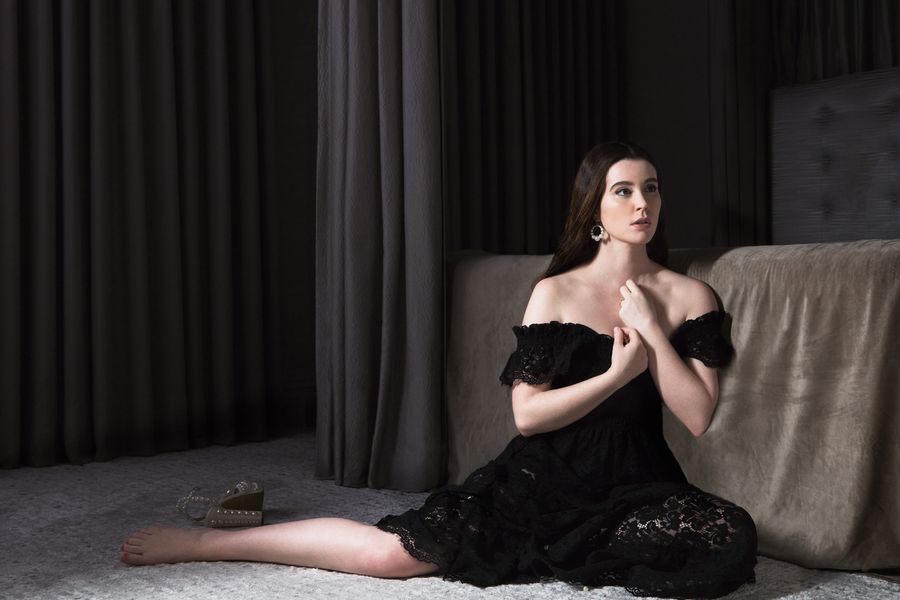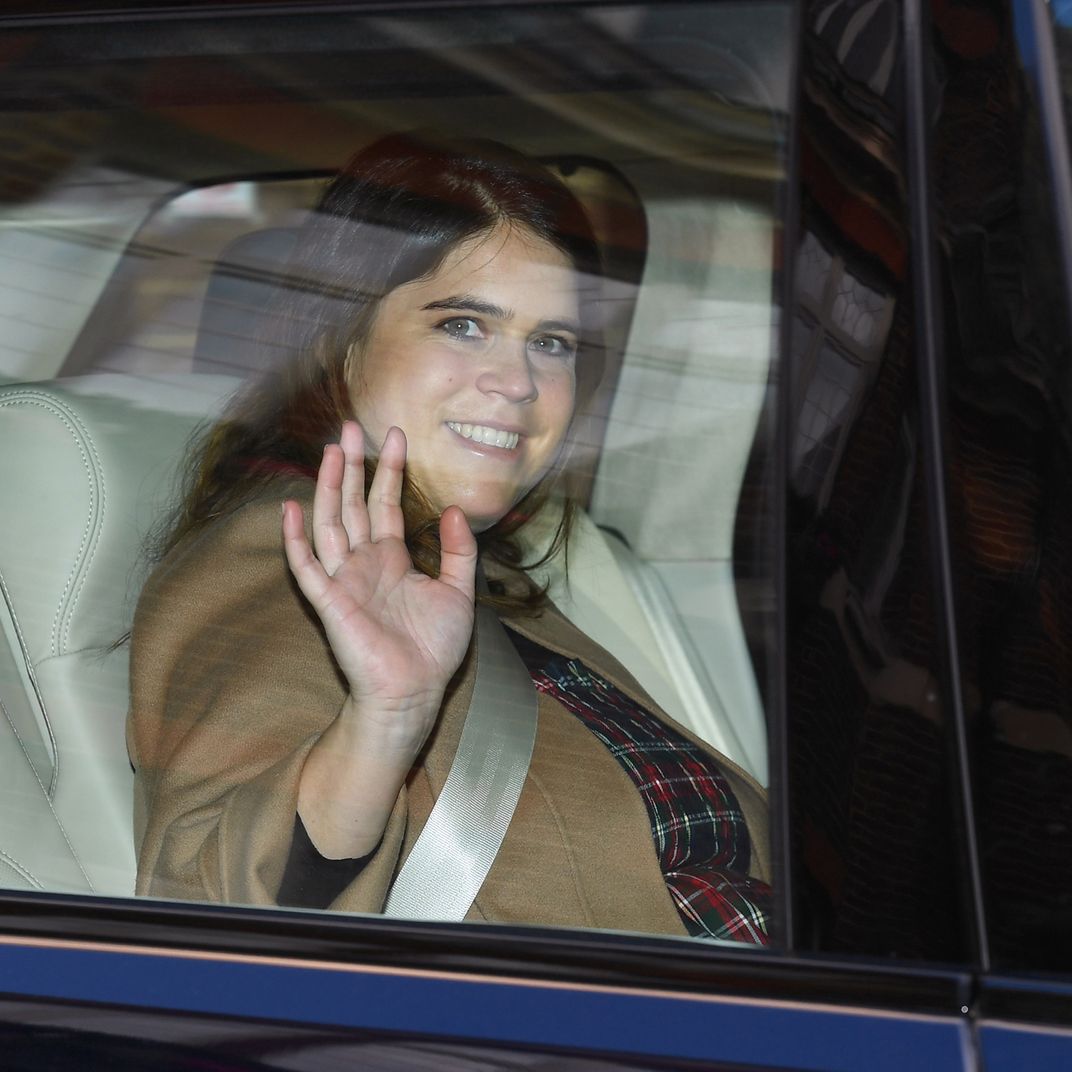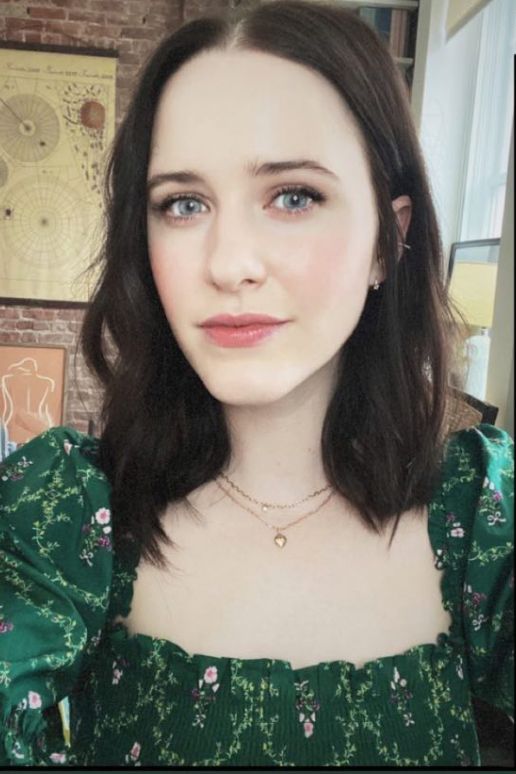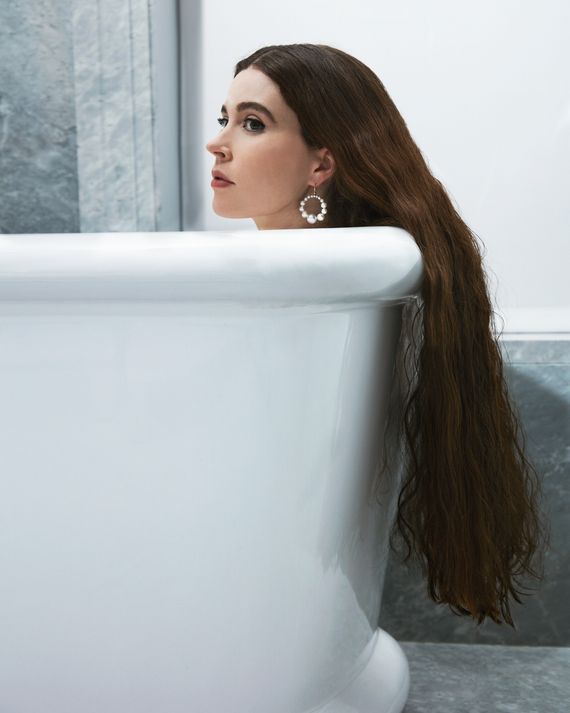
This article was featured in One Great Story, New York’s reading recommendation newsletter. Sign up here to get it nightly.
It is barely 8:30 on a brisk winter morning, the city still on the groggy rise, but Nell Diamond, who is building an empire on the desire never to leave bed, is unmistakably up. Peppy and personable in a red tartan Prada puffer, she had asked that I meet her here, at a Tuscan-themed café near her townhouse in the West Village, before she deposited Henry, the 5-year-old at her side, at his nearby school and then off we’d march to her office. She’s smiling and unharried, effortlessly embodying the agile dream of the entrepreneurial Manhattan mom in perfect control of the morning school-work shuffle. She collects her cappuccino and slips a hand to Henry, who tells me that he has already been fed and watered: “Eggs and prunes and orange juice.”
Diamond is the founder and CEO of Hill House Home, the direct-to-consumer brand she launched in 2016 to offer nesting millennials cozily traditionalist linens their Wasp grandmothers might recognize (damask in flowers, embroidered with their monograms). She named it after the Nantucket family beach house where she spent her summers growing up.
But Hill House’s recent runaway success turned out to be built not on dressing the bed but on the sleeper. In the spring of 2019, Hill House introduced the “Nap Dress,” a $125 cotton pinafore, practical, relatively affordable, somehow both a little modest and a little sexy. When COVID arrived, the fact that it was simple and comfortable enough to sleep in and put-together enough to Zoom in turned it into a sensation. It was well matched for newly shut-in lives. With a forgivingly stretchy smocked bodice and not a single button, zipper, snap, or fastening, it pulls on like sweats with just a skosh less schlump, and with its cottagecore style, it gives even a studio apartment an escapist whiff of a country home. At a time of almost no fashion — we didn’t have anywhere to go, after all — the Nap became, for many young women who follow the trends, all that was left. In 2020, most clothing companies flatlined, but Hill House took off like a rocket. Status bedsheets were a sleepy business. Thanks largely to Nap Dresses, apparel now accounts for 90 percent of the company’s sales.
These days, the Nap Dress is ubiquitous, and to walk through the city’s various young-professional brownstone districts is to see sleepwalkers on parade. It’s available in iterations of bodice, length, and sleeve. Once your eyes adjust to the Nap, you start seeing it everywhere. “Last summer, before I left for the Hamptons, I would take a five-block walk from my apartment to where I pick up my lunch and would lose count of how many people from the ages of 25 to 60 were wearing these Nap Dresses,” one 30-something who lives on the Upper East Side told me. These are the members of what they hashtag #NapDressNation, who eagerly anticipate the quarterly Nap drops, who own the dress in multiples, and who leave comments on Hill House’s website headlined “I’m Addicted,” “Addictive,” and “WARNING: May Cause Addiction.” Celebrities (Emmy Rossum, Princess Eugenie, Mindy Kaling) post photos of themselves wearing theirs. My sister, I found out last fall, owns five of them.
Strolling down the avenue, cheerfully bantering with Henry about his kindergarten-application interviews, Diamond is the Nap Dress girl herself, or what many of them aspire to be. She is striking, with a heart-shaped face, bone-china skin, high cheekbones, and red-brown hair that extends to her middle back, a calling card of sorts — she has been obsessed with long-haired women at least since Princeton, where she wrote her thesis on the “wanton ringlets” of Milton’s Eve and her Pre-Raphaelite inheritors (and today, she does spon-con for Garnier Fructis, the drugstore shampoo). She is also a star on social media, where she is much the same as I find her in person: disarmingly sweet, not obnoxious about her advantages, but not apologetic either.
She is inescapably rich. Her father, Bob, was head of Barclays’ investment-banking division, then its chief executive, and in an earlier era, she might have settled into a social-circuit life of high-stakes PTA meetings and gala fund-raisers, the kind she spent her early 20s attending. Instead, she has become an entrepreneur-influencer on social media, marketing herself by marketing the company, and vice versa. On her own @nelliediamond account, she spent lockdown working from a bay window in her $5.8 million brownstone following the birth of her now-1-year-old twins, Willow and Sebastian, but has since added skiing in Courchevel and celebrating her anniversary with her husband (a handsome marathoner who works in private equity) at Tennessee’s five-star Blackberry Farm resort to the mix, all with a candor and brute-force cheerfulness more surprising for coinciding with a moment when a vocal portion of the tweeting public’s tolerance of poshness and privilege is at a snarling low.
We’ve arrived at the school, and Henry skips off with barely a backward glance. “Henry, I love you!” Diamond calls after him. Another drop-off mother, with expensive-looking highlights, stops her. “It looked like it was amazing yesterday!” she says. “Was it so great?” The day before, Hill House had opened a pop-up shop on Mercer Street. Diamond is warm, polite, and betrays absolutely no indication that she has any idea who this woman is. “Oh, it was the best,” she says. “So happy,” the woman says. “Love your stuff.”
Diamond, by her own admission, was always a girlie girl. She was born in London in 1988, the middle child and only daughter of Bob and Jennifer Diamond. Her father is a meritocratic success story, one of nine children born to an Irish Catholic family outside Boston (his dad was a public-school teacher, then a principal). As he ascended the food chain, first at Morgan Stanley, then Credit Suisse, then Barclays, he moved his family around the globe. Jennifer gave up her own career in product engineering to raise their children and make a home out of whatever corporate apartment they wound up in. “Moving so much, my bedroom was like my little sanctuary,” Diamond says now. “And I really valued waking up in a space that felt like me,” even if her mother’s style is “not as floral forward, a little cleaner” than her own.
Diamond had a taste for glitter from the earliest: In Tokyo, where the family moved when Nell was 4, she never took off the sparkly heels that came with her My Size Barbie, and when the family returned to London in 1997, she experienced retail rapture among the purple eye shadows at the M.A.C store on King’s Road. As she remembers it, her girlie-ness was discouraged. “You are the reason that feminists are never going to succeed,” an Outward Bound instructor told her at 8 when she was afraid to rappel down the side of a mountain.
Little Nell loved to shop and haunted the city’s megaretailers: the Topshop in Oxford Circus and the Gap in Chelsea, where she demanded her mother remain quiet while she communed. Although Hill House today channels a certain mythic, countrified Englishness, as a child abroad, Nell longed for Middle America. When Abercrombie & Fitch opened its first location in London, she was hired as store staff after the brand sent scouts to the American School to find workers with authentic accents. (She never Anglicized.) “I was obsessed,” she says. “I had never lived in America. It was iconic.” She loved the spectacle of retail. “I can see how what I was doing then — which, by the way, I felt guilty about and thought was not something that a smart, educated woman would do — was research,” she says.
Diamond studied English literature at Princeton, where she was conspicuous on campus for her style, wearing heels to class while the norm was sneakers and sweats. “I remember her only because she was the girl with amazing outfits,” a student who overlapped with her told me. Afterward, she took a job at Deutsche Bank in New York. “There’s a huge part of me that has always been trying to fight against this perception of me as this, like, super-silly little girl who wears all the bows and frilly things and blue eyeliner,” she says. “And it was very important to me that I could get that job, and all the quantitative stuff, and pass all the regulated exams. Nobody can tell me the regulator knows who my dad is, that I passed that because of who my dad is.”
But she found herself constricted by banking’s de facto dress code: no bows, no blue eyeliner, no platform heels with her Ann Taylor suits. The night before her first day, she cried for hours, an Elle Woods of Wall Street facing down a dismal future of bland banker-wardrobe rectitude. “It hurt. It physically hurt,” she says with wide-eyed sincerity. “No offense to Ann Taylor. It was really hard, and I also felt guilty for it being so hard. Like, it doesn’t matter. But it does. If I can’t feel like myself, I can’t do anything.”
She endured two years. It was a tumultuous period in her family’s life as well as her own: In 2012, a scandal engulfed her father and ultimately cost him his position. Banks including Barclays, regulators discovered, had been manipulating an interest-rate benchmark called the LIBOR (London interbank offered rate) to goose profits. (Ultimately, Barclays agreed to pay a settlement of over $450 million.) Confidence in bankers’ ethics was already at a low following the crash of 2008–9, and her father — an American in an English institution — became, effectively, the face of banking greed. Politicians piled on, led by Mervyn King, the governor of the Bank of England, and Bob resigned. George Osborne, the chancellor of the Exchequer, called it “the first step toward a new culture of responsibility in British banking,” and Ed Miliband, the leader of the Labour Party, while acknowledging that the problem was not limited to one person, said it “was clear Bob Diamond was not the man to lead the change that Barclays needed.” Diamond, then 23, defended her dad on Twitter. “George Osborne and Ed Miliband,” she tweeted on July 3, 2012, “you can go ahead and #HMD” (“hold my dick”).
Diamond wasn’t famous, but she wasn’t exactly anonymous. As a junior socialite, she was already a regular on the $1,000-a-plate social circuit — there she was at the Soho House Super Bowl party to kick off Fashion Week, the New York City Ballet’s Dance With the Dancers benefit, the NYPL’s Library Lions gala, and the UNICEF Snowflake Ball — and the flare-up made her briefly infamous: the tantrum-ing heiress. (As Bob Diamond told The New York Times Magazine, she called him and said, “ ‘Dad, I think I did something really bad. I think I’m in trouble.’ ” To which he said, “Sweetie, I love you. That’s so nice. I think we’re probably all in trouble.”) Diamond deleted the tweet and replaced it with a more diplomatic one (“Shame to see the mistakes of few tarnish the hard work of so many”), but the damage was done. The British press excoriated her, and the New York Daily News seized on her “24-karat life” and “gilded lifestyle — even if she has a tarnished father.”
She might have gone effectively underground, locking her social-media accounts and avoiding the public eye. Instead, she bore up, newly confirmed in what was important to her (her family) and what was not (the sneering vox populi). “The No. 1 most important thing to me in my life is my family,” she says. “Appearances are not more important to me than protecting people who I love and I know.” Becoming, however briefly, an international object of scorn is a high price to pay for an impolitic tweet, but it also inoculated her. “The experience of hearing people say the worst thing they could ever possibly say about you is in many ways a freeing experience. I can only be who I am,” she says. “Because people, you know, they’re gonna think what they think no matter what.” (Bob Diamond has since founded the private-equity firm Atlas Merchant Capital as well as Atlas Mara, which invests in sub-Saharan Africa.)
Just two years after her father’s very public ouster, she married Teddy Wasserman, a financier ten years her senior whom she’d met at a mutual friend’s birthday party in New York. It was neither a quiet nor a private affair, and an Everybride she was not. A multiday bash at the Hotel du Cap-Eden-Roc — located in Antibes and famous as both the setting for Tender Is the Night and the inn of choice for the Cannes Film Festival — featured multiple gowns. The Daily Mail estimated every dollar spent and noted that the event was orchestrated by the same planner who did Prince William and Kate Middleton’s wedding.
Photos circulated far and wide (the wedding hashtag #nellandteddy was eagerly picked over), and many of the reactions were hostile. “I’m sorry, but no. This girl’s dad is one of those criminal bankers who has helped destroy the global economy. I can’t really take any enjoyment out of seeing her extravagant wedding photos,” wrote a commenter on the beauty blog Into the Gloss, where Diamond shared her hair-and-makeup prep. Others proclaimed their disappointment in the site; one bluntly wrote, “Always good to promote the weddings of such down to earth criminals.”
By the time she was married, Diamond had left her banking job and was a student at Yale’s School of Management. She’d applied with the idea for Hill House Home already in mind. “I wanted to create a brand that made people feel something — the way I felt something about Topshop, about Gap and Abercrombie,” she says. The original pitch for Hill House Home described a bedding line nicer than anything at Bed Bath & Beyond but not as expensive as Frette, marketed in a younger, sexier, more direct way. It was the heyday of disrupters out to upend the brick-and-mortar dinosaurs: Brooklinen and Parachute both launched in 2014. But while those brands favored a more minimal aesthetic — marketing their wares, implicitly or not, as the natural companions to replica mid-century modern — Hill House was full-frontal floral.
“The bedroom is such an important space,” Diamond says. “Even in my dorm room in college, I was like, If I don’t put up my weird pink feather boas and make it all pretty, my day is not gonna be great. I wanted to help people really take charge of those daily things and make them better and more beautiful and more fun.” Jennifer McFadden, associate director of Yale’s entrepreneurial programs, saw from the beginning that the bed would just be a jumping-off point. “I think she really intuitively understood that she was going to build an empire from day one and singularly set forward to do that,” McFadden told me. “She is just probably one of the most natural, talented marketers I’ve ever met.” (Diamond now sits on the School of Management’s entrepreneurship advisory board.)
The company launched in 2016 with a dinner at the Standard hotel attended by the young socialites of Diamond’s friend group and a sizable contingent of Vogue girls, Bee Carrozzini — née Shaffer, Anna Wintour’s daughter — among them. The following year, Vogue returned to Diamond, including her as one of the new “young roses” of philanthropy and society, and in 2018, she was among the eight women and one man of Shaffer’s Tulum bachelorette party.
Over and over, Diamond has declined to be shamed into discretion with a doggedness seemingly born of optimism, stubbornness, and spine. It’s just not in her. She felt it was important to tell me the story from her adolescence about when a group of girls in London grammar school tricked her into eating a slice of pizza they then told her they’d pissed on. In her telling, they all eventually became friends; she won them over by brazening her way through. I found that equanimity surprising, but Diamond shrugged. “People have strong reactions to me. That’s always been the case,” she says. “It’s something I talk about in therapy all the time — but I can’t control other people’s reactions to me; I can only think about how I act and behave and what my values are.” Although, she admits, “obviously, it still gets to me when people DM me mean things or whatever.” Furthermore, she adds, “anything mean anyone’s ever thought about me, I’ve thought about myself.”
But if Diamond’s diamond lifestyle alienates some, it seems to draw in customers. “This is really embarrassing to admit, but I have been following Nell Diamond on Instagram because I saw her wedding in Vogue several years before,” Analeigh Smith, 35, a school development director in Maryland and Hill House fan, told me. “The wedding was so over the top — I was so curious about her life.” She now owns five Nap Dresses.
“It doesn’t surprise me that there is a nation of women who are interested in what Nell does and wears, because I’ve seen people have that interest in her since she was 18, one way or another,” her Princeton classmate Mark Guiducci, the creative editorial director of Vogue, for which he covered her wedding, said. “When anyone is distinctly themselves, that can be divisive. They’re a flavor — it’s not bland.” But, he added, “she was always in on the joke anyway. That’s the thing about her: She gets it, and she’s totally okay with it.”
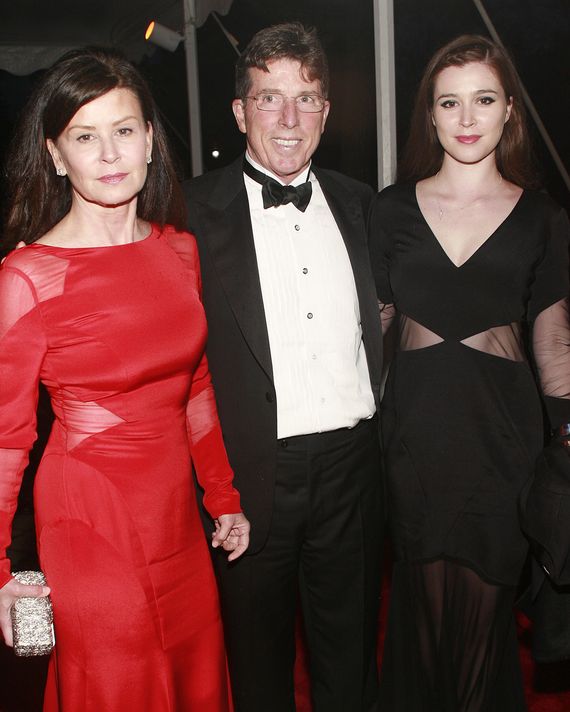
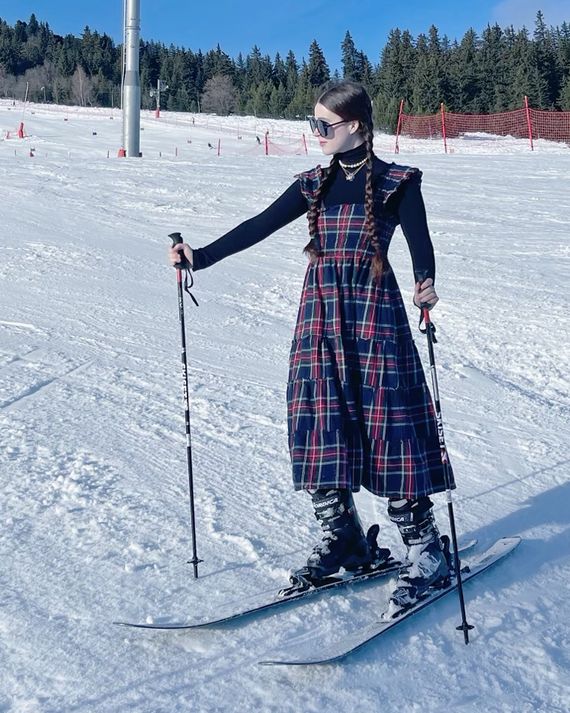
The office that the Nap Dress built is an adorably Instagrammable suite on the 15th floor of a Soho building. Hill House’s previous home was a co-working space Diamond shared with eight or so other brands; with only five employees, it didn’t need much more. When decorating her company digs, Diamond indulged her inner tween, who never seemed that far from the surface anyway. Her own office — her first — is papered in Hill House’s Trellis print, a chintzy pink-and-green floral that was part of Hill House’s “English Garden” collection in February 2021. (Nap Dresses in Trellis have long since sold out, but interested parties can still buy the print as a tablecloth, a pillow sham, sheets, or a duvet cover on the website.) The entryway, with a vanity and mirror and a tassel-curtained closet, is covered every inch in Blue Botanical, a soft, watercolor-like vine-and-flower print in Delft blue. The overall effect is pretty and disorienting, like walking into a dollhouse — or an enormous Nap. (“My 13-year-old self would absolutely die to know I work here,” she posted on IG.)
At the Hill House office, the Nap Dress is, unsurprisingly, de rigueur. At least one person was wearing it in every meeting I attended: a black one on Joslyn Allen Fecik, an alum of Calypso St. Barth and Roller Rabbit who was hired as the brand’s first traditionally trained designer, who wore it over a turtleneck with white Converse; a plaid one on Sara Worth Mullally, who was hired out of college five years ago as a customer-service rep and ascended to become Hill House’s design director; a green velvet one on Allison Greenwell Affinito, the chief product officer, who came last year from Hermès. At the factories where the dresses are made — mostly in China, though other Hill House production is in Italy, Portugal, and New York — “they’re all hooked, they’re all wearing it, they have family members wearing it, and they’re all on the Zooms, all wearing it,” said Nesli Danisman, whose Angora Group worked with Hill House to source materials and set up production. At design meetings, people refer to the dresses, many of which are named after people in Diamond’s orbit — one is named Nesli, another Akilah, after Dr. Akilah Cadet, a diversity, equity, and inclusion consultant who has worked with Hill House — as “she” and “her,” as if in a multiplying sorority of flesh and cloth. “Everybody has their own spin on it,” Diamond says of styling the Nap Dress, though one employee I spoke with had a more pointed take: After a while, she said, “they all kind of look like her.”
The Nap Dress was originally born to be a supporting player. Hill House’s early forays into fashion were tied to its sleep-centric mission. Early on, the company offered pajamas in a more traditional menswear style, with a button-up shirt and trousers. “People just weren’t really responding to it,” remembered Katherine Kapnick, Hill House’s first employee. Diamond was sure there was an opportunity in sleepwear, but she didn’t really want to wear the pajamas herself — she was, after all, a self-proclaimed dress girl who had staunchly refused to wear pants as a kid. (Over several months, I never saw her in a pair.)
As Hill House bedding de-grannied the monogrammed sheets, so would the Nap Dress de-granny the nightgown. In 2018, Diamond began plotting out the perfect one, filling a vision board with images from the 19th-century English painters Waterhouse and Millais, working off vintage nightgowns and tweaking them for comfort and practicality, and using herself as a fit model. (She volunteered “Pre-Raphaelite–core” to describe the look, which is unlikely to catch on.) An email she sent that July, now framed on the wall of her office, memorializes her goal: “to try Nap Dress once and see how it goes. I think if executed well it’s incredible!”
The first Nap went on sale in the spring of 2019 and quickly began outselling all of Hill House’s previous hits. Aside from a few tweaks for functionality (before they were reinforced, the sleeves would eventually begin to droop), the design of one of the original Nap Dresses, the Ellie, a tea-length with frilled sleevelets (matching headband optional), hasn’t changed.
“I don’t think we created anything revolutionary,” Diamond tells me. But success in clothing is more about making the perfect version of something people want rather than something all new they have to get used to. And it had the ideal name, which Diamond trademarked last year. (She never posts about it without its proud ®, as in her Instagram bio: “The Nap Dress® is my fourth child.”) There have been many nightgowns and nightgown-style dresses before — and certainly many, many others since, as fast-fashion retailers raced to knock off the Nap — but part of the dress’s perfection is its succinct title. (“My Nap Dress Is a Big Old T-shirt,” the Cut wrote, making the dress that classic of commerce: a solution in search of a problem.)
The Ellie is still a best seller, but Diamond & Co. have iterated on it in a variety of ways, riffing on past success. (It’s not unheard of for staffers to layer two Naps to create a new look.) The Ellie has been joined by the Elizabeth (shorter), the Samantha (shorter still), the Jasmine (long-sleeved), the Ophelia (puff-sleeved), the Ana (a mini, bow-tied), and the Nesli (puff-sleeved and bow-tied). New fabrics, colors, and prints are constantly added, with “collector’s editions” in tulle and lace priced at around $225.
I ask Diamond about how much she was inspired by Laura Ashley’s dresses, which were popular in the 1980s. But she disputes the connection — that vibe, she tells me, is “very literal, and I like everything we do to have a little bit of irony.” If so, it is an irony not unlike that of Bridgerton, which is to say a mild one. Like Hill House, Bridgerton found smash success channeling a frillier era under the guise of updating or reconsidering it, but with so loving an eye that reconsidering seemed hardly the point. In August, Hill House partnered with Netflix, Shonda Rhimes’s Shondaland, and Meena Harris’s Phenomenal to release three Nap Dresses tied into Bridgerton, tapping illustrator Diane Hill to design a new floral print (in two colorways) for the collection. It was such a success that Hill House has continued working with Hill on upcoming drops.
Nicky Hilton Rothschild.
Hannah Bronfman.
Emmy Rossum.
Princess Eugenie.
Cleo Wade.
Anya Taylor-Joy.
Rachel Brosnahan.
Mindy Kaling.
Nicky Hilton Rothschild.
Hannah Bronfman.
Emmy Rossum.
Princess Eugenie.
Cleo Wade.
Anya Taylor-Joy.
Rachel Brosnahan.
Mindy Kaling.
Literature of the Nap Dress has cropped up to try to explain it, or to contextualize its hold on the popular imagination, or even simply to wish it away. The New Yorker wrote about its “tranquillizing allure,” the promise of “a gauzy, brief escape for those who can afford it.” Elle was less sympathetic, declaring, “The Nap Dress must be stopped.”
“I find these dresses to be really curious,” Robin Givhan, the former fashion critic and current senior critic-at-large of the Washington Post, told me. “It just sort of seems like the exact thing that would not be appropriate for this moment. If the same Nap Dress was something that had been churned out by Walmart, would people have glommed on to it?” Reporting on Diamond, I found skeptics very ready to volunteer their disdain. “The Nantucket vibe is so vile,” one friend told me. “Eat the rich, and she’s first.”
There’s something disconcertingly childlike about the dresses, too, an aura underscored by the fact that Diamond now offers them in baby sizes — a “Tiny Ellie” goes for $75. “My 2-year-old daughter was wearing the same one as a woman walking down the street,” said Meghan Cross, a partner at AmplifyHer Ventures, which invested in the company in 2019. “Talk about inclusive!” Diamond is known for her hair bows and headbands, which Hill House also now makes and sells. “I am nothing,” she posted about one such bow in 2020, “if not loyal to my 7-year-old self.”
The pandemic was all about “cottagecore,” an idyllic or avoidant retreat to country cutesiness, sourdough bread–making, and an allegedly simpler time. It’s tempting to see Hill House as part of a larger wave that includes Batsheva Hay’s funky-frum prairie dresses, which come in both discofied lamé and actual Laura Ashley prints and cost about twice what the Nap Dress does, or Audrey Gelman’s new Six Bells store in Brooklyn, with its backstory fable of a fictional country village and folksy hand-painted cow art.
But where does that leave the cottagecore community when the time comes to exit the cottage? The Nap Dress’s dominance is both a blessing and a burden: It has fueled huge growth but also a less diversified Hill House product mix. Tastes change and trends fade; what happens if the customer decides nap time is over? Web traffic to Hill House Home’s site spiked hugely over the course of the pandemic, going from “nearly zero” in March 2020 to 744,505 monthly visitors in June 2021, said Jim Corridore, a senior insights manager with Similarweb, which tracks online traffic. But traffic data around the 2021 holiday season indicated a significant falloff, “perhaps showing the Nap Dress peaked in mid-2021,” Corridore said. “People will have like 12 of our dresses,” Diamond says. “We don’t need you to buy 13. What do you need to build that out and make it seasonal?”
Several collaborators told me they saw the Nap Dress as the building block of a lifestyle empire, some of whom had a financial interest in this proving to be true; more than one reminded me that Ralph Lauren began his business selling only ties. Now the company is betting that a whole wardrobe might profitably be Napped. At a design meeting one morning, the Hill House team sat around a table and discussed its forthcoming shoe collection, made in Italy, which would include flats and a platform heel in Hill House prints. “One of the slides has to be really extra!” Diamond declares. She fingers a prototype of an embroidered rose motif and considers: “It feels very Beauty and the Beast to me.” Swimwear launches this month, complete with Nap Dress–ish shoulder frills.
Diamond’s investors are betting that her fans will follow her there, and anywhere. The appeal of Nell, and the appeal of the Nap, are not identical, but neither are they easily divorced. Much of Hill House’s success comes from the community it has built directly with its customers online and on social media, and much of that work was done directly by Diamond. It’s working to try to broaden both its reach and its message and ensure that Hill House represents a wide variety of its customers, actual and potential, and that its models are an inclusive group of women of all skin tones and multiple sizes. (It’s clear from visiting the offices that the staff is diverse, too.) But when the Hill House team was reviewing upcoming email and social-media promotion at a meeting I sat in on — one at which Diamond painstakingly rewrote most of the copy in her own voice — it was Diamond herself they wanted to photograph in a velvet Akilah Nap Dress for an upcoming email blast, ideally in the color they had the most stock of to push. “We really think this is going to help boost sales: having an image of you in a holiday dress,” said Worth Mullally, the design director. (“Does it have to be emerald?” Diamond asked. “I’m not allowed to wear any other one?”)
Diamond comes to the role of social-media marketer naturally, or at least generationally; she was 22 the year Instagram launched. And while she no longer hand-types every caption on the @hillhouse account — she officially gave up day-to-day management of it two years ago, though Kapnick remembers trying in vain before she left Hill House in 2018 to persuade her to pass off the job much earlier — she oversees all of its content. I wondered whether she would be posting as eagerly, as constantly, without a business to fluff. She thought so. Sitting in her office, she slipped a dark-silvery ring off one of her fingers: It was a sleep-and-activity-tracking smart device called Oura that measures heart rate and body temperature. “I’ve always said that I get very calm by scrolling through social,” she says. “And this proved it.”
When investors circle Hill House — as they have and continue to — it is Diamond herself (love her or hate her) who is the secret ingredient. “The main thing we look for is the founder who has a unique ability to create viral growth, and Nell absolutely demonstrates that,” said Cross, the AmplifyHer investor who also brought in Peter Thiel’s Founders Fund to invest in the company. “I can most certainly say from my experience looking at 1,200 companies a year that Hill House Home’s revenue growth far surpasses that of many of the fastest-growing direct-to-consumer brands.” Because of Diamond’s social-media acumen, the company’s marketing spend remains low, less than 5 percent of its revenue last year; by contrast, one investor I spoke with estimated that 40 cents of every venture dollar invested in start-up businesses goes directly to Google or Facebook for marketing.
Last month, Hill House closed a Series B investment round at a valuation of $150 million. There is much to do with that capital: more hires (a first director of brand marketing just came onboard, from Bumble), for one thing, and a permanent brick-and-mortar outpost in Manhattan, following on the success of a pop-up shop over the winter holidays. That store had suggested that if you can draw new customers in to Hill House’s world, they will join Nap Dress Nation; according to Diamond, one out of every two people to walk through its doors bought something, and average order values were higher in the store than online. So after Manhattan, who knows? The heartland appeal of Hill House is obvious: Dallas is the No. 2 market after New York with Chicago behind.
Hill House is Diamond’s house and Diamond’s fantasy, where the world looks just like she wants it to. “I literally cried when I saw this stuff,” Diamond said, pausing before a mirrored display of padded headbands when we visited that holiday pop-up. “This is what I dreamed of my whole life.”



